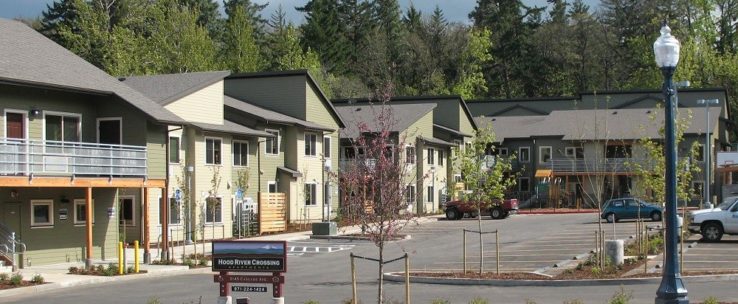Hood River Sixth Oregon Jurisdiction to Enact Construction Excise Tax to Fund Housing

In late July, the City of Hood River, Oregon became the sixth jurisdiction in the state to impose a Construction Excise Tax to generate local funding for affordable homes. Hood River will use 50% of the funds to provide incentives for developers to build affordable housing and 35% for affordable housing programs, with 15% directed to Oregon Housing and Community Services’ down payment assistance program. The City of Hood River CET will generate as estimated $165,000 annually.
In the 2016 the Oregon legislature passed SB1533, establishing a new authority for cities and counties to impose a Construction Excise Tax (CET) in order to fund local affordable housing by harnessing the state’s development boom. The City of Portland was the first to enact the CET in June 2016, followed by the city of Corvallis in November. In May 2017, the city of Cannon Beach enacted a CET, with Tillamook County and Hood River County taking action in June.
With both the City and the County of Hood River having adopted a CET the jurisdictions will coordinate the targeting of the funds to meet the range of housing needs in an area that is both agricultural community and very popular tourist destination. The City will use theirs to benefit people up to 80% of AMI, while the County will use theirs to benefit people up to 120% of AMI. The County will use their industrial/commercial CET funds for developer incentives, rent subsidies, down payment assistance and foreclosure assistance, as well as expenses that have a nexus related to housing creation, such as infrastructure, roads and water.
The CET is on new construction or construction adding square footage to an existing structure. For residential construction, the tax is assessed at a maximum rate of 1% of the value of the permit value of the construction, although local jurisdictions can enact a lower CET. For new commercial and industrial construction, with there is no cap on the rate of the CET. Jurisdictions that impose a CET may utilize up to 4% of revenues as a fee for administering the tax. After the administrative fee, the residential CET revenues are to be distributed as follows:
- 50% to developer incentives such as fee waivers, property tax exemptions, and other financial incentives.
- 15% to Housing and Community Services Department to fund homeownership programs that provide down payment assistance.
- 35% for affordable housing programs and incentives as defined by the local jurisdiction.
For a CET imposed on commercial or industrial development, 50% of revenues after the administrative fee must be expended on programs related to housing.
Tillamook County, located on the Oregon coast, will use the CET as a primary funding source for a Community Workforce Housing Development fund (CDWHF). Of the residential CET, 50% of revenue will fund finance-based incentives for CDWHF programs that require affordable housing and 35% to the CDWHF to support the production and preservation of housing affordable for families at or below 80% Area Median Income. 100% of CET generated by commercial development will go to the CDWHF, serving households up to 200% AMI.
The growing number of Oregon jurisdictions enacting the CET is an example of the powerful impact of state enabling legislation. State enabling legislation refers to a range of initiatives taken at the state level to make it possible, easier, or even encourage cities and/or counties to create their own housing trust funds. These range from states passing legislation enabling cities or counties to create housing trust funds to legislation that actually identifies a revenue option and provides matching funds. Including Oregon, fourteen states have enacted enabling legislation, including Arizona, California, Florida, Indiana, Iowa, Massachusetts, Missouri, New Jersey, Pennsylvania, South Carolina, Washington, Wisconsin, and most recently Minnesota.
“Communities across Oregon are experiencing a housing crisis, and our state needs more affordable places to call home,” said Jenny Lee, Housing Policy Director for Neighborhood Partnerships. “A construction excise tax is one way that cities and counties can have locally controlled resources to meet the needs of their residents. All jurisdictions in Oregon should be considering this important tool to build more affordable homes.”
Other cities considering implementing a CET to address the lack of affordable homes include the cities of Astoria, Eugene, McMinnville, Newport, Salem, and Sisters.
To learn more about Oregon’s Construction Excise Tax, contact Jenny Lee at the Neighborhood Partnerships: jlee@neighborhoodpartnerships.org.







